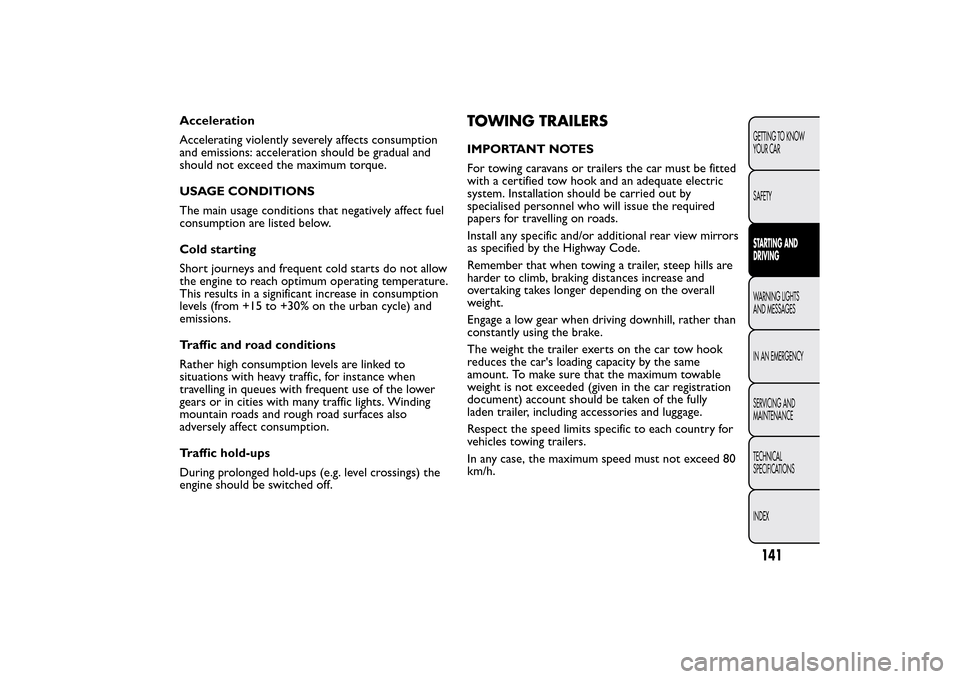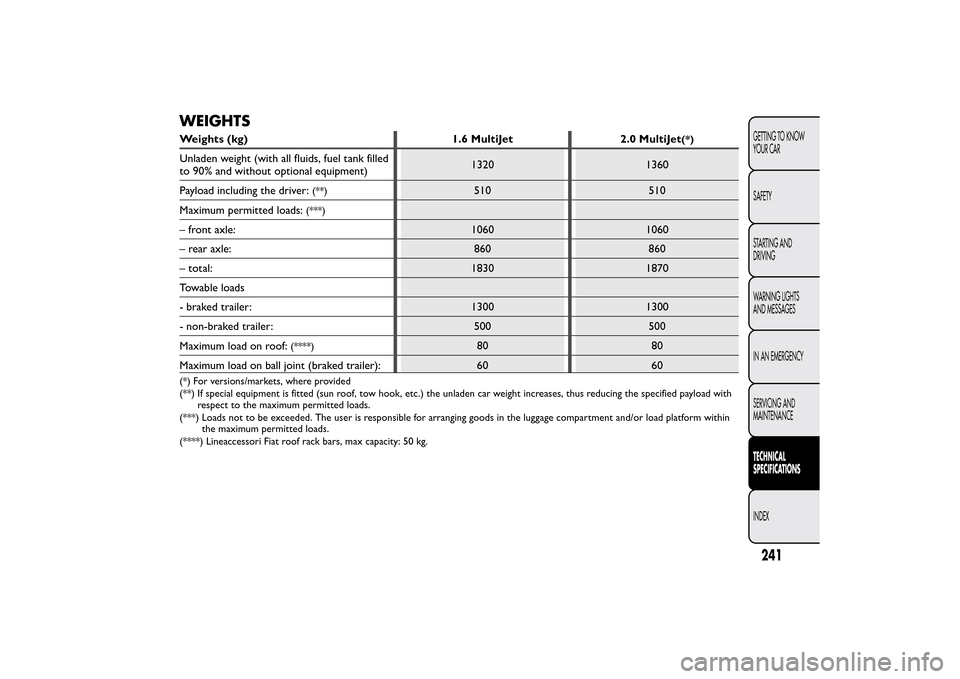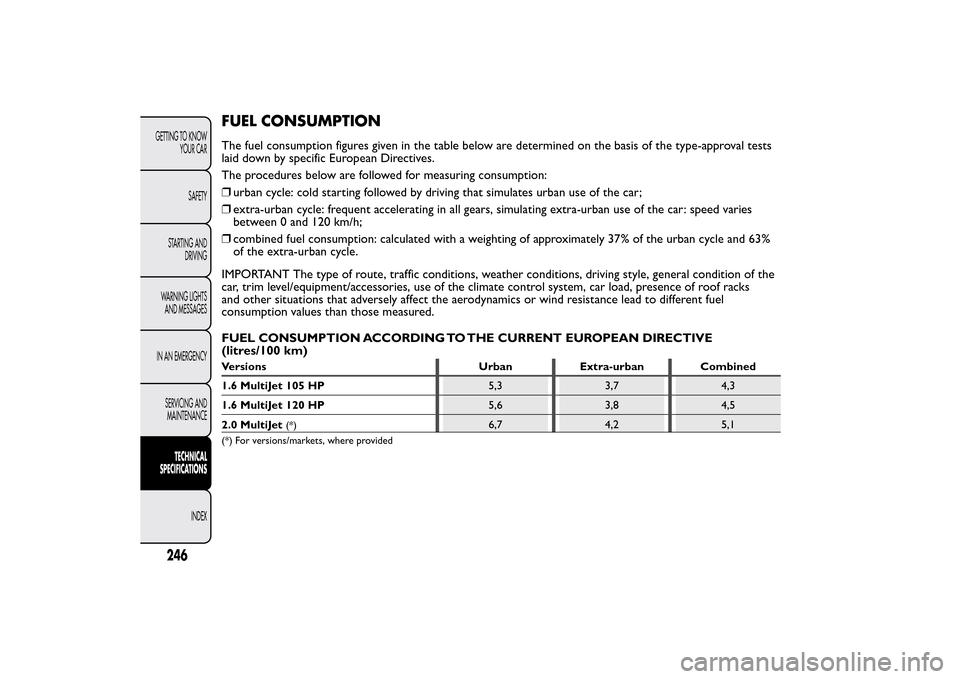2014 FIAT BRAVO weight
[x] Cancel search: weightPage 145 of 275

Acceleration
Accelerating violently severely affects consumption
and emissions: acceleration should be gradual and
should not exceed the maximum torque.
USAGE CONDITIONS
The main usage conditions that negatively affect fuel
consumption are listed below.
Cold starting
Short journeys and frequent cold starts do not allow
the engine to reach optimum operating temperature.
This results in a significant increase in consumption
levels (from +15 to +30% on the urban cycle) and
emissions.
Traffic and road conditions
Rather high consumption levels are linked to
situations with heavy traffic, for instance when
travelling in queues with frequent use of the lower
gears or in cities with many traffic lights. Winding
mountain roads and rough road surfaces also
adversely affect consumption.
Traffic hold-ups
During prolonged hold-ups (e.g. level crossings) the
engine should be switched off.
TOWING TRAILERSIMPORTANT NOTES
For towing caravans or trailers the car must be fitted
with a certified tow hook and an adequate electric
system. Installation should be carried out by
specialised personnel who will issue the required
papers for travelling on roads.
Install any specific and/or additional rear view mirrors
as specified by the Highway Code.
Remember that when towing a trailer, steep hills are
harder to climb, braking distances increase and
overtaking takes longer depending on the overall
weight.
Engage a low gear when driving downhill, rather than
constantly using the brake.
The weight the trailer exerts on the car tow hook
reduces the car's loading capacity by the same
amount. To make sure that the maximum towable
weight is not exceeded (given in the car registration
document) account should be taken of the fully
laden trailer, including accessories and luggage.
Respect the speed limits specific to each country for
vehicles towing trailers.
In any case, the maximum speed must not exceed 80
km/h.
141GETTING TO KNOW
YOUR CAR
SAFETYSTARTING AND
DRIVINGWARNING LIGHTS
AND MESSAGES
IN AN EMERGENCY
SERVICING AND
MAINTENANCE
TECHNICAL
SPECIFICATIONS
INDEX
Page 146 of 275

WARNING
The ABS with which the car may be
equipped will not control the braking
system of the trailer. Particular caution is
required on slippery roads.
WARNING
Never modify the braking system of the
car to control the trailer brake.The
trailer braking system must be fully
independent of the car ’s hydraulic system.
INSTALLING THE TOW HOOK
The towing device should be fastened to the
bodywork by specialised personnel according to any
additional and/or integrative information supplied
by the Manufacturer of the device. The towing device
must meet current regulations with reference to
Directive 94/20/EEC and subsequent amendments.
For any version the towing device used must be right
for the towable weight of the car on which it is to
be installed.IMPORTANT The use of auxiliary loads other than
external lights (electric brake, winch, etc.) must
be used with engine running.
For the electric connection a unified connector
should be used, which is generally placed on a special
bracket fastened to the towing device, and a special
ECU should be installed on the car to control the
trailer's exterior lights.
7 or 13-pole 12 V DC connections should be used
(CUNA/UNI and ISO/DIN Standards). Follow any
instructions provided by the car manufacturer and/or
the towing device manufacturer.
An electric brake or winch should be powered
directly by the battery through a cable with a
cross-section of no less than 2.5 mm
2.
IMPORTANT Electric brakes or other devices must
be used with engine running.
In addition to the electrical branches, the vehicle's
electrical system can be connected only to the supply
cable for an electric brake and to the cable for an
internal trailer light, though not more than 15 W. For
connections use the preset control unit with battery
cable no less than 2.5 mm
2.
142GETTING TO KNOW
YOUR CAR
SAFETYSTARTING AND
DRIVINGWARNING LIGHTS
AND MESSAGES
IN AN EMERGENCY
SERVICING AND
MAINTENANCE
TECHNICAL
SPECIFICATIONS
INDEX
Page 168 of 275

JACK
Please note that:
❒the jack weight is 1.76 kg;
❒the jack requires no adjustment;
❒the jack cannot be repaired and in the event of a
fault it must be replaced by another original one;
❒no tool other than its cranking device may be
fitted on the jack.
To change a wheel proceed as follows:
❒stop the car in a position that is not dangerous for
on-coming traffic where you can change the wheel
safely. the ground must be flat and sufficiently
compact;
❒turn the engine off and pull up the handbrake;
engage first gear or reverse; use handle A to
remove the rigid preformed cover B fig. 123;❒loosen fastener E fig. 124;
fig. 123
F0Q0732
fig. 124
F0Q0392
164GETTING TO KNOW
YOUR CAR
SAFETY
STARTING AND
DRIVING
WARNING LIGHTS
AND MESSAGES
IN AN
EMERGENCY
SERVICING AND
MAINTENANCE
TECHNICAL
SPECIFICATIONS
INDEX
❒for versions equipped with the “Fix&Go
Automatic” kit, take the tool box from the luggage
compartment;
Page 229 of 275

TECHNICAL SPECIFICATIONS
IDENTIFICATION DATAThe identification data of the car are:
❒VIN plate;
❒Chassis marking;
❒Bodywork paint identification plate;
❒Engine marking.
VIN PLATE
This plate is fitted to the engine compartment front
crossmember and contains the following data
fig. 183:BType-approval number.C
Vehicle type identification code.
D
Chassis serial number.
EMaximum authorised weight of vehicle fully laden.FMaximum authorised weight of vehicle fully laden
plus trailer.G
Maximum authorised weight on first (front) axle.
H
Maximum authorised weight on second (rear)
axle.
IEngine type.LBodywork version code.M
Number for spare parts.
N
Correct value of smoke coefficient (for diesel
engines).
fig. 183
F0Q0029
225GETTING TO KNOW
YOUR CAR
SAFETY
STARTING AND
DRIVING
WARNING LIGHTS
AND MESSAGES
IN AN EMERGENCY
SERVICING AND
MAINTENANCETECHNICAL
SPECIFICATIONSINDEX
Page 245 of 275

WEIGHTSWeights (kg) 1.6 MultiJet
2.0 MultiJet
(*)
Unladen weight (with all fluids, fuel tank filled
to 90% and without optional equipment)1320 1360
Payload including the driver:
(**)
510 510
Maximum permitted loads:
(***)
– front axle: 1060 1060
– rear axle: 860 860
– total: 1830 1870
Towable loads
- braked trailer: 1300 1300
- non-braked trailer: 500 500
Maximum load on roof:
(****)
80 80
Maximum load on ball joint (braked trailer): 60 60
(*) For versions/markets, where provided
(**) If special equipment is fitted (sun roof, tow hook, etc.) the unladen car weight increases, thus reducing the specified payload with
respect to the maximum permitted loads.
(***) Loads not to be exceeded. The user is responsible for arranging goods in the luggage compartment and/or load platform within
the maximum permitted loads.
(****) Lineaccessori Fiat roof rack bars, max capacity: 50 kg.
241GETTING TO KNOW
YOUR CAR
SAFETY
STARTING AND
DRIVING
WARNING LIGHTS
AND MESSAGES
IN AN EMERGENCY
SERVICING AND
MAINTENANCETECHNICAL
SPECIFICATIONSINDEX
Page 250 of 275

FUEL CONSUMPTIONThe fuel consumption figures given in the table below are determined on the basis of the type-approval tests
laid down by specific European Directives.
The procedures below are followed for measuring consumption:
❒urban cycle: cold starting followed by driving that simulates urban use of the car;
❒extra-urban cycle: frequent accelerating in all gears, simulating extra-urban use of the car: speed varies
between 0 and 120 km/h;
❒combined fuel consumption: calculated with a weighting of approximately 37% of the urban cycle and 63%
of the extra-urban cycle.
IMPORTANT The type of route, traffic conditions, weather conditions, driving style, general condition of the
car, trim level/equipment/accessories, use of the climate control system, car load, presence of roof racks
and other situations that adversely affect the aerodynamics or wind resistance lead to different fuel
consumption values than those measured.
FUEL CONSUMPTION ACCORDING TO THE CURRENT EUROPEAN DIRECTIVE
(litres/100 km)Versions Urban Extra-urban Combined
1.6 MultiJet 105 HP5,3 3,7 4,3
1.6 MultiJet 120 HP5,6 3,8 4,5
2.0 MultiJet
(*)
6,7 4,2 5,1
(*) For versions/markets, where provided
246GETTING TO KNOW
YOUR CAR
SAFETY
STARTING AND
DRIVING
WARNING LIGHTS
AND MESSAGES
IN AN EMERGENCY
SERVICING AND
MAINTENANCE
TECHNICAL
SPECIFICATIONS
INDEX
Page 273 of 275

Technical data ........................... 225
The keys ........................................ 8
Third brake light......................... 182
Towing the car............................ 199
Towing trailers ............................ 141
TPMS ............................................ 100
Transmission ............................... 230
TRIP button ................................. 29
Trip computer
– TRIP button ............................ 29
– Trip Computer....................... 28
– Trip Computer values .......... 28
Tyres
– correct tyre reading............. 233
– Fix&Go Automatic (kit)...... 169
– inflation pressures ................ 238
– snow tyres ............................. 234
– tyres provided ....................... 234
Tyres - maintenance .................. 214U
sing the gearbox .................... 138
Volume sensing/Anti-lift
protection .................................. 15W
arning lights on panel .......... 146Washer fluid for
windscreen/rear
window/headlights ................... 211
Weights and loads...................... 241
Wheel geometry........................ 233
Wheel rims
– correct reading of the
wheel rim ............................... 234
– dimensions ............................. 234
Wheels and tyres
– changing a wheel .................. 162
– Fix&Go Automatic (kit)...... 169
– Wheels and tyres ................. 214
Window cleaning ........................ 55
Windows (cleaning) .................. 221
Windscreen washer nozzles ... 218
Windscreen washer/wiper ....... 55
Windscreen wiper
– blades ...................................... 216
– blades replacement .............. 217
Wiring for radio system ............ 95
269GETTING TO KNOW
YOUR CAR
SAFETY
STARTING AND
DRIVING
WARNING LIGHTS
AND MESSAGES
IN AN EMERGENCY
SERVICING AND
MAINTENANCE
TECHNICAL
SPECIFICATIONSINDEX